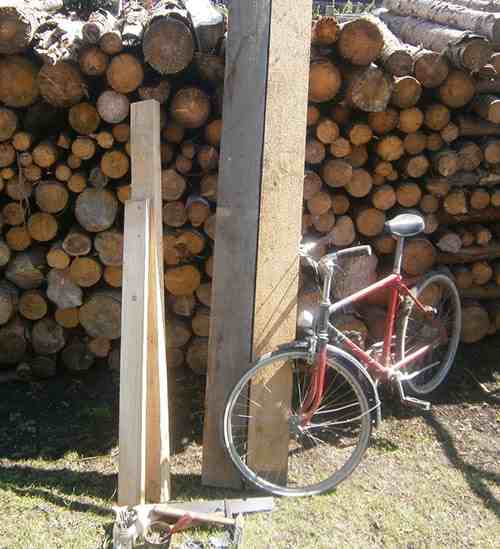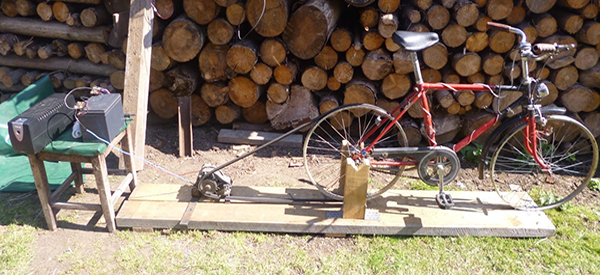Making your own bicycle generator is a good addition for those who are interested in going off the grid and finding a way to live on their own terms. It not only generates electricity but also provides you with a great cardio workout, which could be an alternative to going for a run and a good addition to anyone’s life.
Related: How to Build an EMP Emergency Car Bag
Building the generator is simple if you have the motivation, creativity and, of course, the items necessary to build it:

- Two 50-inch x 6-inch x 2-inch wooden planks
- One 24-inch plank (or a height that would be enough to lift up the back wheel of your bike when the plank is cut in two)
- A short plank that will connect the two 50-inch planks
- A saw
- Nails of different sizes
- A Phillips screwdriver
- Screws
- Hammers
- A nail puller
- Metal L corner braces in two different sizes
- A fan belt
- A car alternator
- A battery
- A voltage regulator
- A switch
- And, of course, the bike itself

Related: Tools You Will Need When SHTF
First, we need to set up the base of the generator. Start with the two 50-inch wooden planks and put them next to each other. Saw the 24-inch-long plank down the middle into two pieces. Nail these planks to the 50-inch-long wooden plank at the top and bottom, creating the base. Place the bike onto the base, and draw a line at the bike’s cassette sprocket onto the boards. Cut the 24-inch wooden plank into two, and cut a triangle onto one end of each. With screws and the corner braces, fix the planks vertically each side of where you marked the sprocket.
You should end up with something similar to mine.
Put some sort of lock at the front of the base that will stop the front wheel from moving. I found some bendable metal braces that I used to secure the front wheel.
To try it out, I put the bike onto the base with the front wheel locked tightly in place.
The front wheel was locked tightly. The back wheel was sitting firmly on the stand, slightly above the base, which made it able to spin. The next step was to take apart the hub of the back wheel to release it from the frame of the bike, put the fan belt onto the wheel then reattach the wheel to the bike frame. Find a way to attach the alternator to the wooden base. I found a piece of metal that I cut to size and drilled holes into. 
Put the fan belt onto the alternator, and see how far you can pull it out to make the belt tighter.
After finding the perfect spot, draw a line so you can see where to screw the piece of metal.
Next I attached the alternator to the piece of metal then attached the fan belt with the motor. 
To make the belt tighter or looser, I attached a piece of metal that looked similar to a clamp and connected it to the motor with a bolt and a nut.
I drilled a hole into the ground to make a place for the other bolt. I also attached another piece of metal to the wood where I made the hole in order to make the bolt stronger. Now I was able to make it tighter or looser.
Because I want to show that this system really works, I prepared two light bulbs; one of them was a 12-volt, 8-watt bulb, while the other was a 110-volt 20-watt bulb. For this, I needed an inverter because of the higher voltage needed. To set it all up I got an inverter, the battery, a soldering iron and solder, and a multimeter.
Install the voltage regulator to the alternator to add the switch. This way the alternator can be turned off and won’t steal the electricity inside the battery while it’s out of use. Attach the positive (red) wire to the motor.
- Connect the negative (blue) wire to the voltage regulator.

- Connect the switch (white wire) to the system with one end attached to the same spot on the alternator where the positive wire went. Connect the other one to the B+ (the right one) on the voltage regulator. Connect the motor to the regulator, and attach the wire to the DF on the regulator.

- Now the button should be functioning.

- Attach the positive and negative wires to the battery to finish.

- To try out the system, I grabbed my soldering gun and the 12-volt light bulb. I first started out by wrapping the positive wire around the light bulb.
- Using the solder gun, I attached the negative wire to the bottom of the bulb.

I started pedaling the bike.
The light bulb lit up with ease. You can see that the light bulb isn’t attached to the battery. It is connected to the clamps of the inverter (which was turned off) and the multimeter to measure the amount we can make.
Depending on how hard you pedal, how strong the alternator is, and how big the bike wheel is, you could get different readings. I consistently got around 14–15 volts out of it.
I then put the clamps back onto the battery and turned the inverter on to see if I could light up the 110-volt light bulb.
You can see the light bulb on the ground and that the inverter is on.
For video instructions, follow this link: https://www.facebook.com/askaprepper/videos/2076827509221045/
You may also like:
 5 Things You Need to Do When There’ll Be No Rule of Law
5 Things You Need to Do When There’ll Be No Rule of Law
You Will Not Survive An EMP Strike Without This (video)















Do you have a video? I did not see some of the things you commented on.
Did I miss something (after reading this twice)? It will light up a 110 volt light bulb. But for how long? And is that the only thing you can power?
The idea is that it’ll power anything the battery has enough charge for. The light bulb is an example, to show that with an inverter you can run 110 volt devices. Obviously there’s limits to what the current from a battery can power, but if you need a way to recharge batteries for radios, flashlights or weapon accessories, and you don’t have any serious generating capacity, this definitely looks like an option.
WHY DID YOU NEED A VOLTAGE REGULATOR, MOST ALTERNATORS HAVE BUILT IN REGULATORS NOWADAYS, PLUS IF THE ALTERNATOR ISN’T SPINNING IT SHOULDN’T DRAW THE JUICE OUT OF THE BATTERY, EITHER WAY A SWITCH CAN BE HOOKED TO THE COMPONENTS OF THE BUILT IN REGULATOR, ALSO, IF YOU WANT A FASTER CHARGE AND LESS EFFORT, USE A 10 SPEED, AND A FEW DOLLAR CHAIN INSTEAD OF A 50 DOLLAR V-BELT, HOOK THE CHAIN ON THE BIGGER SPROCKET ON THE BACK WHEEL, KEEP THE BIKE IN THE LOWEST GEAR, WELD A SPROCKET TO THE ALTERNATOR, CHARGE TIME WOULD BE REDUCED REMARKABLLY BY USING THE TEN SPEED.
go to youtube.com, they multiple videos on this subject.
Yes, I saw soilent green too……..
how long does it take to charge a battery? Its one thing to be able to generate electricity, But if it takes 3 hours of peddling to charge up a battery, or it can’t deliver enough amps to run a refrigerator, then its more of a novelty than a sustainable source of power. You don’t want to spend all your time peddling and burning calories when you should be busy working on other aspects of your survival and conserving food.
But still, interesting article.
That was a great movie! Thanks for bringing that back to mind 🙂 I forgot about Sol peddling that thing!
A great idea; if you have a bunch of eager kids to take turns. Not for me, though 🙂
It isn’t going to run a refrigerator, but it could be a great solution for keeping small electronics charged. Would you base your whole SHTF power supply on this? No. Is it a handy piece of knowledge because you can build one from scrap if you have to? I’d say so.
you know i have always liked this it has been something i have done as a kid and think not only as a SHTF power supply but as a off grid charger it would do wonders around the homestead. It is simple and easy and most people like easy.
I have two thoughts about this: 1- could you convert an old exercise bike for this and 2- could you power a camping cooler or coffee pot ? I think they’re 12 volt.. Also made me think of the tv show Gilligan’s Island and how they powered the radio.;-)
I think an old exercise bike might be easier to convert than a normal bike, because an exercise bike already has some way to keep it vertical and some way to keep the rotating wheel off the ground. Everybody knows the professor in “Gilligans Island” was really smart and he wouldn’t worry about a bike generator, he would build a small nuclear power station out of a couple of coconuts and some string.
I would agree. One tool in a box. And a unique power source that can be assembled out of scavenged parts.
But perhaps we are putting too much reliance and need on an modern infrastructure that might not survive an EMP blast, or similar disaster.
2022 is Soylent Green year LOL photovoltaic/solar thermal technician here. the bicycle charging the battery scene had me hooked when i saw it in the movie theater ’73
Where such a generator will prove invaluable is when your off-grid solar system experiences several cloudy days in a row, your batteries may suffer an alarming drop, and pedaling may mean your refrigerator will keep running.
I am very grateful for all the valuable information you’re putting out. Thank you so much for sharing your wisdom. Everything that I’ve purchased from you and learn from you has been just as described And I look forward to learning more and being prepared.
I don’t think it is worth the effort to try until somebody can give us an idea how many amps you can generate with it. I’ve wondered about this idea for years but never wanted to pioneer it. I was thinking of starting with an Air Dyne machine if you could find a cheap one on a yard sale. It’s all about the RPMs you can get the alternator spinning. I suspect that it will take a lot of muscle power to get a substantial amount of electricity.
Googling I read that a human can generate .1 to .25 hp unless you are an athlete which can do more. 1 horsepower = 746 watts @ 100% efficiency. A bike and alternator might be 50% efficient at best. So… 746 watts x .25(human power) x 50% effeciency = 93 watts of power. Pretty substantial to charge a battery. However if you are a .1 hp human,, than we are down to 37 watts.
I think time and money would be better spent on a solar panel. No work for me and the panel can work many hours a day and should outlast the bike/alternator.
Spike….you’ve got the numbers pretty close. Go to any gym exercise bike, or that Air Dyne, and set the panel readout to watts…..the average person will do good to generate 40-50w for 1/2hour. A small 50w solar panel will generate 6-8 times that in a 6hr window of sun.
Bike generators are a joke.
I’m not so confident about the ability of solar panels to survive an EMP, though. I don’t know if this has been tested, but common sense says they could be vulnerable. Solar panels are designed to convert sunlight into electricity. What’s sunlight? It’s EM radiation. Is an EMP going to overload and destroy the panel? I wouldn’t like to find out unless I have a mechanical backup in place.
I don’t think attacking an idea is rational. I’m not an electrician or a mechanic but I can tell there must be an easier or better way to produce electric however instead of attacking the idea what would be more constructive is brain storming how to tweak it. I like the idea of powering the battery. I agree solar is easier and after but we don’t always have the sun. This could be an additional source. First I thought the wood frame won’t last very long before it falls apart. Maybe put frame of bike over a steal frame or horizontal rod hooked to something. Stationary bike first came to mind because it’s already in fixed position but she’ll not big enough and it’s harder to pedal. Ten speed seems best for this particular experiment. I would attach the alternator to the bike frame that way you can use a cheaper smaller belt. No need to solder wires to a bulb with and inverter just plug in a lamp. I know worrying about electric may seem rediculous in a crisis but I would want to be able to heat up some water on a hot plate. Would a car battery generate enough power to do that?
while i agree it is a waste of time, i must oint out that an alternator runs off RPM, not HP. A 100 amp alternator must turn at 1200 RPM to produce 100 amps. At 600 RPM it will generate half that or 50 amps. So if you increase the diamater of the drive wheel and reduce the diameter of the driven you could, theoretically, produce enough RPM to get 100amps with little effort. As a note a 100 amp alternator will produce no more than 100 amps no matter how fast it turns.
I thought about doing this to power the TV or XBox when my kids we’re still at home!
I made a similar system a few years ago, but I had the bike running on rollers, and they drove the alternator, this worked OK, but the power was a bit low and it took hours to charge a flat battery, so I connected 2 more alternators to this system, this had an output of 150 amps, but to charge the flat battery it was like riding the bike up a very steep hill for almost an hour. The advantage of my system was I still had the bike for transport after recuperating from charging the battery.
I would say it would be worth it if you have an old bike, battery and alternator lying around.
You just happened to have a humongous fan belt sitting around? Where did it come from? Most of the fan belts I’ve seen are a small fraction of that size.
Serpentine belt…most new vehicles use one belt to drive everything. Tension is provided by a spring-loaded idler arm.
MY FRIENDS;
THAIS JOB IS VERY EASY WITH WATER,
IN YOUTUBE I SEE ONE MAN.(spanish)
IN CUBA ISLAND;
THIS WORK, WITH THE PRESION OF WATER IN THE CREEK…
THE WHEEL DO SPINNING THE ALTERNATOR…
& YOU SEE TV, SOUND THE RADIO, LOPTOP ETC, ETC. LOOK IT.????
You need some type of water fall for power to a whole lot of people will have access to that and who knows how people,will be acting in time of long term crisis. It would be nice to believe everyone will band together to help each other out but when food and water are scarce a lot of people are just out for themselves
On my land I have a year round spring 70′ higher than my camp, so my intention is to use the Alaskan glacial melt water to power my micro hydro system.
Btw, my land is in Arkansas.
The bike generator is not designed for charging up your microwave or anything more than small devices. The mistake those of you who put down the idea, is that you’re thinking of it as a total solution. The real value and advantage of this setup is that it can be easily built, built cheaply and with several setups, people can exercise and contribute to charging a battery and keep cellphones, radios and small lights charged up. If you were desperate enough, you’d pedal for hours to charge up a phone the same way you’d walk a mile or more for fresh water if you had no other choice.
If you ever buy a windup flashlight or radio, you’ll see that pedaling would be easier than cranking by hand and thus more efficient and effective as it’s less tiresome although cranking for 1-2 minutes isn’t a big deal. If I had a choice, I’d rather pedal for 5 minutes and get more power. In any case, hand crank, bike generator or a small solar panel providing a little power is better than none or waiting to “find” a source and/or having to trade or barter for it.
Sure, and of course the cell towers, digital phone systems, and internet are all going to survive an EMP…… the only small “appliances” that may need to be charged are radios. but now that we have switched to “digital broadcastings”, there is no guarantee that that will work either.
The electrical source you are going to need long-term is going to have to be sustainable. hook it up to a pelton wheel, or wind turbine, and you have a power source. Hook it up to a bicycle, and you can charge your cell phone, -to use the alarm clock.
Ideally, you reduce your need for electricity. Its not like you are going to be able to go grocery shopping, then refrigerate your ice cream.
Smoked meats, live poultry and eggs, if we are talking long term, Or canned goods, if its only a “natural” disaster, and short term.
That being said, it is a way to generate a limited amount of power with things you can scavenge in an emergency.
This idea been around for a very long time. Good for small needs and charging batteries. A good alternative motive force would be stream or wind, of course good flow on both would be required. Its still a good project for learning. Never discount learning and experimenting.
Have not seen one of these hooked up to a ten-speed bike what are the advantages of the gearing if any. I’ve taken my fat derriere (and the rest of me too) up some steep hills with one.
good info, thank u.hook up paddles stand er next to a creek and let er rip.
Back in the,70s a neighbors kid peddled to watch tv. That was all it did. But better than soft lazy kids.
Personally this great grandma will vote for a solar panel. Now if the bike were running an efficient washing machine I might consider it.. hmmm… no… still going for solar panels.
Hi Clergylady, I have just watched an Australian history movie, ( John Flynns Outback ) and they had radios in very remote areas mainly used to call the “Flying Doctor” that were peddle operated, and this was in the 1930’s. I would think if peddle power was ever going to be used as a main power supply, it would of happened before now, but still its usable, and unlike putting all your eggs in the one basket like some people do, I have many large solar panels charging 2 monstrous forklift batteries, I also have torches, radios and a lap top computer that have their own small solar panels for re-charging, but as well I have a diesel powered generator that runs on old cooking oil and I’m seriously looking at a locally made wind turbine that is only NZ$800 and is rated at 3300 watts, sure, not enough to operate my home, but plenty for a washing machine.
Escapee, that sounds like a good plan.
I’m looking,at some serious solar and wind generation.
If you are pre-preparing, look for a premiant magnet generator like they use in partible wind turbines. if you have the time and $$ you can find them up to the 8 to 10 Kilowatt rand and on down to 1 wat like the bicycle head lite genies. they have the advantage of not having to have an exciter voltage source. Look also at camping generators with a bad motor and good generator. they come in ranges from less than a kilowatt and up.